
AutoCAD – VIEWBASE for 3D onto Paperspace
Introduction
I’ve had some customers recently complaining about the way AutoCAD works with Viewports. They are fine for 2D, but when you put 3D solids in the viewport it is really frustrating trying to get hidden lines to show how you would like… or expect. Maybe frustrating is being too mild.
So I was surprised, given that the VIEWBASE command was introduced in AutoCAD 2012 that they hadn’t even heard of it, let only tried it in anger. So here are some steps to follow to get it working.
Below is the drawing I want to produce. I want hidden lines to show in both the Top View and the Front View. In the Isometric View I want to change the scale to make it slightly smaller on the sheet, and I don’t want hidden lines to show. Then instead of a Right Side View, I want to show a Section Cut. Finally, and I want to set the colour and weight of the visible edges, hidden edges, and hatching to match my CAD Standards. All of these are really easy to produce using the VIEWBASE command.
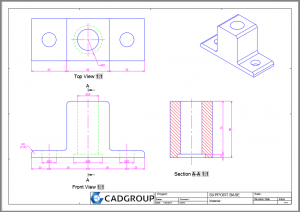
First I want to make sure that it is 3rd Angle Projection. To do that we use the VIEWSTD command and set it as follows:
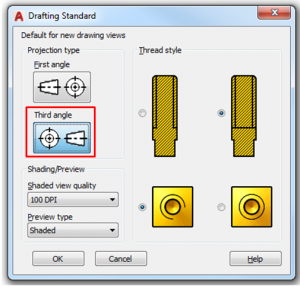
Another thing to bear in mind, before we place the VIEWBASE details on the sheet, is what orientation you used in modelspace. Which view angle do you consider to be the Front View? Basically, I modelled this object in relation to other 3D objects without considering the orientation required when detailing it in isolation. But now that I look at it, what I consider to be the front of the object is aligned with the Left view of the View cube as you can see below. Ultimately this will affect the orientation to set when placing the first View. This will be more obvious later, but needs be considered prior to leaving Modelspace.
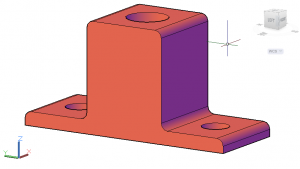
- So having drawn my 3D model I go to a layout tab. For the VIEWBASE command to work you must be in paper space.
NOTE: Because of this is a requirement, the VIEWBASE command was changed to force the selection of a Layout if you started the command in modelspace.
2. If there are viewports showing, delete them. We are only using VIEWBASE in this example.
3. Type in the VIEWBASE command and pick the source. AutoCAD wants to know where the 3D model lives.
The options are model or file. File is used to select an Inventor file. For my AutoCAD work, I choose Model. The ribbon shows options for you to change some of the settings.

Orientation of the Drawing View
4. Remember I spoke about the orientation earlier. If I use the AutoCAD Front View, the view that gets placed ends up like this.
That’s because it’s what we see if we align our view in Modelspace to the Front orientation on the viewcube. But the VIEWBASE command has an option to resolve this issue. In my case I want VIEWBASE to take the view in modelspace from the Left side, and make it my Front View.
So I will set the Orientation (for the front view) to Left. Although you can use the ribbon, I find it easier in this case to type Orientation, and Left.
Place the Front View
5. You are then required to locate the position of the front View on the sheet. Click to place it. Then in the Ribbon you can adjust the appearance. I left it on Hidden Lines, which means display hidden lines as well as visible lines, and clicked the OK button to place the view.

Generate Views in relation to the Front View
From now on it’s as simple as move the mouse and click. The mouse move defines the direction of the view to be created and the click places the view. Each click creates a new view. So beyond our original Front View there are 8 more options for the views you can create.
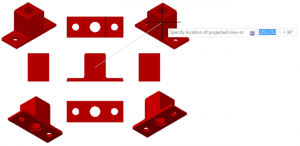
So to create my original plan, I moved upwards to create a Top View, and then up and to the right to create an isometric view. When that is completed click the enter key. This will generate the views where you placed them and with the options you chose.
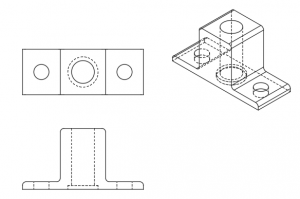
NOTE: If you create too many views you can delete the ones you don’t want. If you haven’t created enough, you can Project more views from any existing View. Note that the orientation will be set based on the orientation of the starting View. If you want to try this, generate some views from the Top View and see how the Isometrics orient themselves.
8. So back to my original plan. As you can see hidden lines are showing in both the Top View and the Front View. This was the frustrating bit with Viewports, but with VIEWBASE, the drawing views that are created show this perfectly.
Set the Scale of a Drawing View
9. Next, I want to make the Isometric View slightly smaller on the sheet. To adjust that click on the Isometric Drawing View Grey border. This will show a grip point at the centre of the view, and a drop arrow.
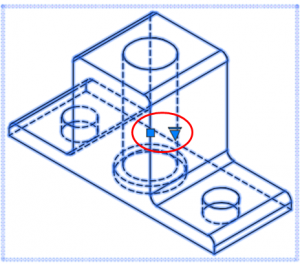
With the drop arrow you can change the scale.
NOTE: This list of scales comes from whatever you set using the SCALELISTEDIT command.
The From parent option, shown below, is selected by default. It means this Drawing View will inherit the scale from the Parent View, which is the Front view we placed first. This is a useful feature, as it means changing the scale of the Front View will automatically adjust the scale of all of the related drawing views.
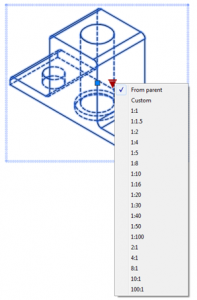
In this case I am choosing to have a different scale for the Isometric, to the other views. I will set it to a custom scale of 1:1.5 to make it slightly smaller on the sheet.
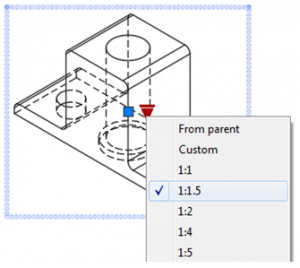
Remove Hidden Lines from the Isometric View
10. Also, I don’t want hidden lines showing in the Isometric View. With the view selected, the Ribbon should have changed.
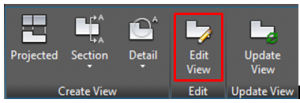
I will select Edit View this time, but we will explore some of the other options later. In editing the View change, the Appearance from
Visible and Hidden Lines (From Parent)
to
Visible Lines
as is shown below.
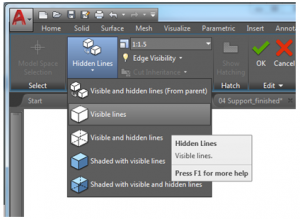
Again, the From Parent option which we saw before means that this view previously followed the settings for display of the Parent (Front View).
Click OK to apply these appearance settings.

Create the Section View
11. Then instead of a Right Side View, I wanted to show a Section Cut. To do that I click on the grey border of the Front View. Then in the Ribbon choose the Full Section View command.
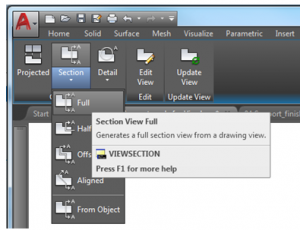
12. This will prompt you to select the location of the section cut. Snap to the mid points of the Front View as shown.
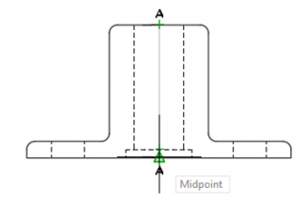
13. Having picked the two points, all I need in this case, click Enter. This requests a locating point for the Section Cut View.

14. Click to locate the Section, and Enter to generate the View.
Define Visible, Hidden, and Hatch display
15. Finally, I want to set the colour and weight of the visible edges, hidden edges, and hatching to match my CAD Standards. This is done as you would expect it, with changes to Layers. These are the layers generated with the Views I created. I changed the colours to match my requirements, and these updated on the Drawing Views.

Put in some annotation, and there you have it.
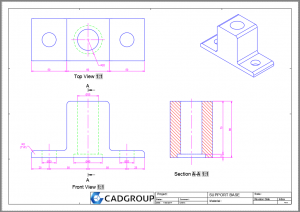
16. How easy was that? So for those of you frustrated with what happens with Viewports and 3D objects, I hope you have some fun trying out the options of the VIEWBASE command. It may be an oldy, but it is definitely a goody.

